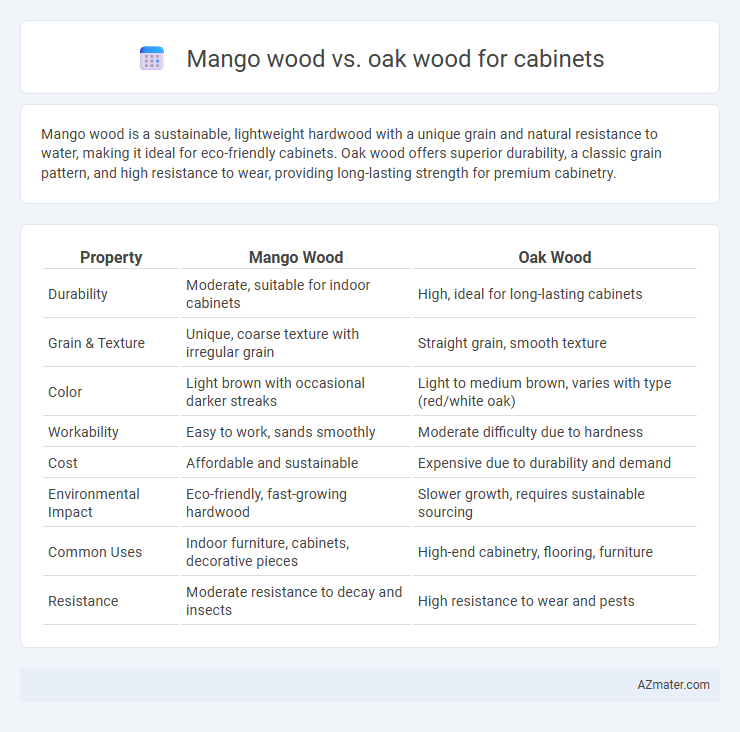Mango wood is a sustainable, lightweight hardwood with a unique grain and natural resistance to water, making it ideal for eco-friendly cabinets. Oak wood offers superior durability, a classic grain pattern, and high resistance to wear, providing long-lasting strength for premium cabinetry.
Table of Comparison
| Property | Mango Wood | Oak Wood |
|---|---|---|
| Durability | Moderate, suitable for indoor cabinets | High, ideal for long-lasting cabinets |
| Grain & Texture | Unique, coarse texture with irregular grain | Straight grain, smooth texture |
| Color | Light brown with occasional darker streaks | Light to medium brown, varies with type (red/white oak) |
| Workability | Easy to work, sands smoothly | Moderate difficulty due to hardness |
| Cost | Affordable and sustainable | Expensive due to durability and demand |
| Environmental Impact | Eco-friendly, fast-growing hardwood | Slower growth, requires sustainable sourcing |
| Common Uses | Indoor furniture, cabinets, decorative pieces | High-end cabinetry, flooring, furniture |
| Resistance | Moderate resistance to decay and insects | High resistance to wear and pests |
Introduction: Mango Wood vs Oak Wood for Cabinets
Mango wood and oak wood both offer durable options for cabinets, but they differ significantly in texture, hardness, and sustainability. Mango wood is a fast-growing, eco-friendly hardwood known for its smooth grain and warm hues, making it ideal for contemporary cabinet designs. Oak wood, prized for its strength and prominent grain patterns, provides a classic, long-lasting finish well-suited for traditional and high-traffic cabinetry.
Overview of Mango Wood
Mango wood is a sustainable hardwood known for its durability and resistance to warping, making it an excellent choice for cabinet construction. Its unique grain patterns and warm, rich tones offer a distinct, exotic appearance compared to the classic, heavier grain of oak wood. Mango wood cabinets are lightweight yet strong, providing an eco-friendly alternative that ages gracefully with a natural patina over time.
Overview of Oak Wood
Oak wood, prized for its durability and distinct grain patterns, is a premium choice for cabinet construction, offering exceptional strength and resistance to wear. Its tight grain structure and high tannin content provide natural resistance to moisture and insects, making it ideal for long-lasting furniture. Compared to mango wood, oak presents a more traditional and luxurious aesthetic with a heavier, denser composition suitable for high-end cabinetry.
Durability and Strength Comparison
Mango wood offers moderate durability and strength, making it suitable for lightweight cabinetry, while oak wood is renowned for its exceptional hardness and long-lasting durability, ideal for heavy-use cabinets. Oak's dense grain structure provides superior resistance to dents and scratches compared to mango wood, which is softer and more prone to wear over time. For robust, high-traffic kitchen cabinets, oak wood outperforms mango wood by delivering enhanced strength and longevity.
Appearance and Grain Patterns
Mango wood features a warm, golden-yellow hue with unique, irregular grain patterns that create a rustic and exotic look for cabinets. Oak wood displays a consistent, prominent grain with tight, straight lines and a lighter to medium brown shade, offering a classic and timeless appearance. The distinct grain textures of mango provide a more varied and artistic aesthetic, while oak's uniformity lends itself to traditional and elegant cabinetry styles.
Sustainability and Environmental Impact
Mango wood is a sustainable option for cabinets due to its fast growth rate and the use of trees that have already served their fruit-producing lifecycle, reducing deforestation pressure. Oak wood, while durable and strong, has a slower growth rate and its harvesting often involves cutting mature trees, which can contribute to habitat loss and higher carbon emissions. Choosing mango wood cabinets supports eco-friendly practices by promoting the use of a renewable resource with a lower environmental footprint compared to traditional oak wood.
Workability and Ease of Customization
Mango wood offers superior workability due to its softer texture, making it easier to cut, carve, and shape compared to the denser and harder oak wood. Oak wood, though more challenging to work with, provides excellent strength and durability, requiring specialized tools for customization. Customization on mango wood is more flexible with intricate designs and finishes, while oak is preferred for traditional, sturdy cabinet styles.
Maintenance and Care Requirements
Mango wood cabinets require moderate maintenance with occasional oiling to preserve their natural luster and prevent drying or cracking. Oak wood cabinets demand more consistent care, including regular polishing to maintain their durability and prevent moisture damage due to their porous structure. Both woods benefit from gentle cleaning with non-abrasive products to avoid surface damage and retain their aesthetic appeal.
Cost and Value Considerations
Mango wood cabinets offer a cost-effective alternative to oak, providing durability and a unique grain pattern at a lower price point, making them ideal for budget-conscious projects. Oak wood, known for its strength and classic appeal, commands a higher cost but delivers long-lasting value and a timeless aesthetic that can enhance property resale potential. Choosing between the two depends on balancing upfront investment with desired longevity and style impact in cabinetry.
Final Recommendation: Which Wood is Better for Cabinets?
Mango wood offers affordability, sustainability, and a unique grain pattern, making it ideal for budget-conscious cabinet projects with a rustic or exotic look. Oak wood excels in durability, hardness, and a classic appearance, providing long-lasting strength and traditional style for high-traffic or premium cabinetry. For cabinets requiring superior strength and timeless appeal, oak is the better choice, while mango wood suits eco-friendly selections and distinctive aesthetics.

Infographic: Mango wood vs Oak wood for Cabinet
 azmater.com
azmater.com